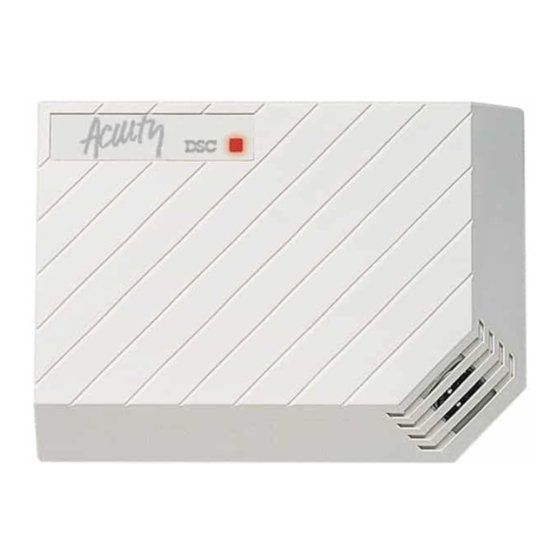DSC Acuity AMA-100 Istruzioni per l'installazione - Pagina 2
Sfoglia online o scarica il pdf Istruzioni per l'installazione per Sensori di sicurezza DSC Acuity AMA-100. DSC Acuity AMA-100 4. Addressable glass break detector

Level of Detection (Jumper J2)
The AMA-100 glass break detector comes with a "detection level" jumper setting
(Jumper J2), which allows the selection of one of two levels of detection,
depending on the size and acoustics of the room in which the detector will be
installed. This improves the overall false alarm immunity of the detector.
The detector is factory preset for Level 1 detection (Jumper J2=OFF). This is the
highest sensitivity setting of the detector, and is designed for applications
requiring high sensitivity and range, such as larger rooms, or rooms which
contain a significant amount of sound-absorbing surfaces (such as carpets,
furniture, drapes, etc.). Level 1 will be suitable for most applications.
For rooms which are smaller, and contain a significant amount of hard, sound-
reflective surfaces (such as kitchens, bathrooms, entrances etc.), Level 2
detection (Jumper J2=ON) provides a lower sensitivity setting which is more
appropriate for these environments.
NOTE: Jumper J1 is not used and must always be left on.
Locating The Detector
NOTE: Test the detector thoroughly for proper placement using the AFT-100
Glass Break Simulator. Other simulators may trip the unit, but will not
provide accurate indications.
• For optimum protection, the detector should have a direct line of sight to the
protected glass.
• Window coverings will absorb sound energy from the shattering glass. In these
cases, mount the detector as close as possible to the protected glass, either
on an adjacent wall, the ceiling, or behind the window covering if possible.
• The detector should be mounted at least 1.8m (6 feet) off the ground.
• Do not mount the detector on the same wall as the protected glass. Refer to the
diagram below for correct and incorrect mounting locations.
• Avoid installation near "noisy" sources, such as speakers or other objects
which produce sounds continuously.
• Do not install the detector beyond the maximum recommended range, even if
the AFT-100 simulator shows additional range - future changes in room
acoustics could reduce that additional range.
• Application on 24 hour loops should be avoided unless the location is
unoccupied.
• Test false alarm immunity by creating any sounds in the room which will likely
occur when the alarm system is armed.
D = Distance
